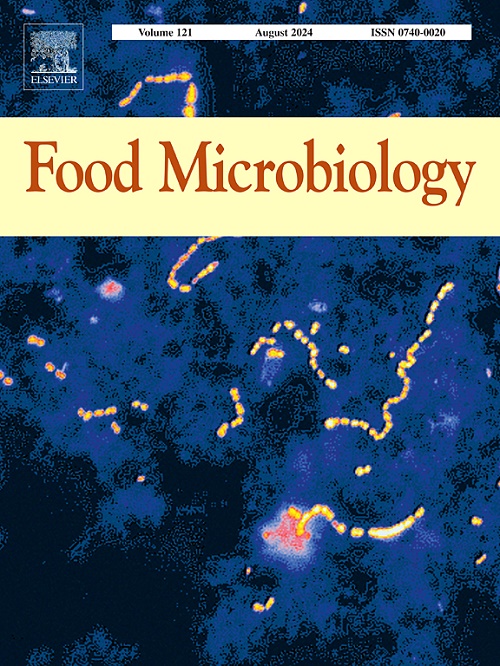用254 nm和279 nm紫外线系统灭活磷酸盐缓冲盐水、苹果汁和椰子水中的甲型肝炎病毒
IF 4.5
1区 农林科学
Q1 BIOTECHNOLOGY & APPLIED MICROBIOLOGY
引用次数: 0
摘要
除了传统的汞灯254 nm UV-C系统外,新型的279 nm紫外发光二极管(UV-C LED)正在研究其广谱抗菌活性。本研究的目的是确定用传统的254 nm UV-C和279 nm UV-C LED处理时,在磷酸盐缓冲盐水(PBS, pH = 7.2)、苹果汁(AJ, pH = 4)和椰子水(CW, pH = 5)中灭活甲型肝炎病毒(一种有弹性的食源性病毒)所需的剂量。对每种被测液体,500 μL HAV (~ 5 log PFU/mL)与4.5 mL液体在玻璃烧杯内混合,用254 nm UV-C(最大剂量33.89 mJ/cm2)连续处理0-15 min,或用279 nm UV-C LED(最大剂量7.03 mJ/cm2)连续搅拌0-10 min。采用混合模型方差分析(SAS v 9.4)对3个重复的恢复病毒计数进行统计学分析。HAV在PBS和CW中的d10值(1 log PFU灭活所需剂量)在279 nm UV-C下分别为4.37±0.61和5.59±1.16 mJ/cm2,显著低于254 nm UV-C下分别为15.27±2.01和10.46±0.53 mJ/cm2 (p≤0.05)。然而,279 nm UV-C LED对AJ HAV的d10值为4.02±0.27 mJ/cm2, 254 nm UV-C LED对AJ HAV的d10值为3.31±0.61 mJ/cm2。HAV对254 nm UV-C处理的敏感性在AJ中最高,其次是CW和PBS。总的来说,279 nm UV-C LED系统显示了在目标剂量下测试流体中HAV灭活的潜力,而视觉上没有变化,这值得进一步研究以扩大规模。本文章由计算机程序翻译,如有差异,请以英文原文为准。
Hepatitis A virus inactivation in phosphate buffered saline, apple juice and coconut water by 254 nm and 279 nm ultraviolet light systems
Novel ultraviolet light emitting diodes (UV-C LED at 279 nm) are being investigated for broad-spectrum antimicrobial activity in addition to traditional mercury-lamp 254 nm UV-C systems. The goals of this study were to determine the doses required for hepatitis A virus (a resilient foodborne virus) inactivation in phosphate buffered saline (PBS, pH = 7.2), apple juice (AJ, pH = 4), and coconut water (CW, pH = 5), when treated with traditional 254 nm UV-C compared to 279 nm UV-C LED. For each tested liquid, 500 μL of HAV (∼5 log PFU/mL) was mixed with 4.5 mL liquid within glass beakers and treated for 0–15 min with 254 nm UV-C (maximum dose of 33.89 mJ/cm2) or for 0–10 min with 279 nm UV-C LED (maximum dose of 7.03 mJ/cm2) with continuous stirring. Mixed model analysis of variance (SAS v 9.4) was used to statistically analyze the recovered viral counts of three replicates. HAV in PBS and CW showed significantly lower D10-values (dose required for a 1-log PFU inactivation) of 4.37 ± 0.61 and 5.59 ± 1.16 mJ/cm2 with 279 nm UV-C LED than 15.27 ± 2.01 and 10.46 ± 0.53 mJ/cm2 with 254 nm UV-C, respectively (p ≤ 0.05). However, D10-values for HAV in AJ of 4.02 ± 0.27 mJ/cm2 by 279 nm UV-C LED and 3.31 ± 0.61 mJ/cm2 by 254 nm UV-C were obtained. HAV showed the highest sensitivity to 254 nm UV-C treatments in AJ followed by CW and PBS. Overall, 279 nm UV-C LED systems show potential for HAV inactivation in the tested fluids without visual changes at the target doses, which warrants further investigation for scale-up operations.
求助全文
通过发布文献求助,成功后即可免费获取论文全文。
去求助
来源期刊

Food microbiology
工程技术-生物工程与应用微生物
CiteScore
11.30
自引率
3.80%
发文量
179
审稿时长
44 days
期刊介绍:
Food Microbiology publishes original research articles, short communications, review papers, letters, news items and book reviews dealing with all aspects of the microbiology of foods. The editors aim to publish manuscripts of the highest quality which are both relevant and applicable to the broad field covered by the journal. Studies must be novel, have a clear connection to food microbiology, and be of general interest to the international community of food microbiologists. The editors make every effort to ensure rapid and fair reviews, resulting in timely publication of accepted manuscripts.
 求助内容:
求助内容: 应助结果提醒方式:
应助结果提醒方式:


